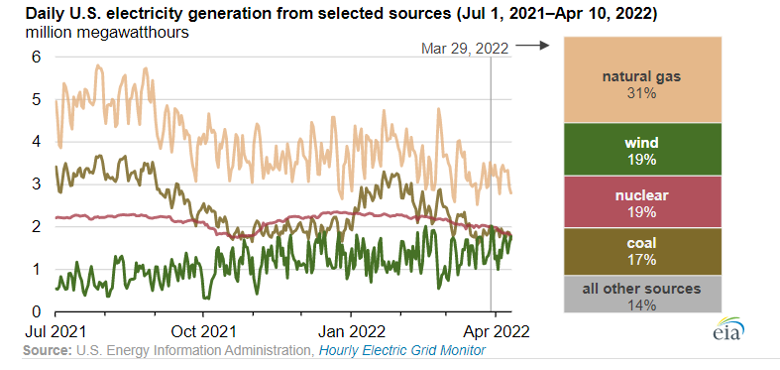

Good News for 2023
Wind Power Is Trouncing Coal
The energy landscape of the United States is changing. And last year illustrates just how far we’ve come. In March 2022, wind power supplied nearly 20% of the power in the U.S., as you can see in this chart from the Energy Information Administration:

That’s not renewable power in total… that’s just wind power. Granted, this is just one month out of the year. But it’s an indication of the changes we see in the mix of energy. If we go back to 2000, coal was the fuel of choice. Coal power supplied 52% of the electricity in the U.S. Natural gas was second, with 16%. All renewables (solar, wind, and hydro power together) generated just 9%. Fast forward to 2020 and coal supplied just 19% of the power. Natural gas jumped up to 41%. And all renewables accounted for 20% of the electricity. That means in the past 20 years, coal power shrunk by 1,193 billion kilowatt-hours. And while natural gas replaced most of that decline, renewable power grew by 427 billion kilowatt-hours.And much of that renewable growth came from wind power.
In 2021, wind power accounted for around a third of new energy production, according to the U.S. Department of Energy. In 2021 alone, the U.S. installed 13 gigawatts of wind power. That was an 11% increase in the total U.S. wind capacity in a single year. Wind power alone provides enough electricity to supply 40 million U.S. homes. It provides more than 50% of the electricity in both Iowa and South Dakota. As you can see in the chart below, wind is on a tear:

And capacity isn’t the only thing growing. It’s also the size of the wind turbines themselves. From 2020 to 2021, the average wind turbines were 9% larger. Wind power really wasn’t important before 2010. But it’s grown incredibly since then. The numbers from March 2022 are an indication that this trend will continue.At Mangrove Investor, we see sustainable power companies as a great place to invest right now. The growth in wind and solar power means that these small power companies have a lot of room to get larger. That’s good for the country and it’s good for our investment accounts!
For the Good,
Matt Badiali

Numbers to Know
3.8%
The percentage of key minerals that is Lithium in a Lithium battery. The batteries name sake actually makes up a small percentage of the EV batteries total key materials percentage with metals like Copper, Aluminum and Nickel taking a much larger percentage of the whole. (visualcapitalist.com)
$73 Billion
The amount of investments announced in 2022 for U.S. based electric vehicle focused plants. Although proposed to be all over the U.S., the majority are in the South East which is now being called the new “Battery Belt” (nor.org)
33%
The percent of people who feel battery life is a big concern when considering to purchase an Electric Vehicle (EV). But some of this concern may not be warranted as the industry is starting to see most EV batteries are lasting longer than expected. Estimates now range between 15 to 20 years for most EV’s. (EV Box)
What’s New in Sustainable Investing
Seimens 1 GE 1 as the Haliade-X Patent Infringement Dispute Continues
Wind energy is big business and the battle over the biggest blades is getting heated. Following Seimens Gamesa patent infringement lawsuit win against GE in the US, GE comes away with a decision in their favor within the UK courts. (Juve Patent)
Closing the loop on EV battery recycling
As the need for batteries continues to rise the need to source the precious metals required to build them will too. It will not be practical or good for the environment to dig our way to all those batteries. But there are some companies that are trying to solve the battery recycle puzzle which will be vital to the electric-vehicle future. (sae.org)
Video Of The Week
Haliade-X offshore wind turbine
Talk about big blades, check out the Haliade-X wind turbines on the Dogger Bank in the North Sea sandbar. These wind turbines are set to be the world’s most powerful and efficient ocean-based wind turbines in operation. Generating enough clean energy to power up to six million households


